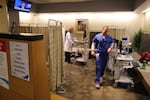While COVID-19 hospitalizations in Oregon are less than half what they were at their peak last fall, hospitals in the state are struggling to operate normally.
Hospital executives and state officials say a combination of financial struggles, increasing hospitalizations due in part to COVID-19 and severe staffing shortages have led to fewer available beds in some areas.
Central and Southern Oregon have been especially hard-hit, state epidemiologist Dr. Dean Sidelinger told reporters at a press conference Wednesday, especially St. Charles Medical Center in Bend.
But no hospital in Oregon has been spared, he said.
Even though there might be physical beds available, some hospitals don’t have the staff to utilize those spaces.
“It is kind of a domino effect,” Sidelinger said.
Oregon health officials are urging people in 21 counties with high COVID-19 cases — including the three Portland-area counties — to return to mask wearing to help with the strain the hospitals are experiencing.
Long hours, full beds

A March 2019 photo of emergency department staff at St. Charles Medical Center in Bend. Nearly all inpatient beds at the hospital are occupied this week.
Emily Cureton / OPB
In Bend, 96% of inpatient adult beds at St. Charles Medical Center were occupied on Tuesday, with six more patients in the emergency room waiting to be admitted to the hospital, according to spokesperson Kayley Mendenhall.
Patients in need are not being turned away, she said.
Last week, the hospital’s chief medical officer told providers to brace for “the hardest challenges we have seen in the last two years.”
“Now more than ever, we must have no patient in a hospital bed who doesn’t absolutely need it,” Chief Medical Officer Doug Merrill said in a July 15 email.
Two St. Charles nurses told OPB that their working conditions have worsened in recent months, with many providers not able to take scheduled breaks and working as long as 16 hours a day in some cases.
“The working environment and staffing at St. Charles, … it has gotten worse, horribly worse,” said Megan Bovi, who’s been a registered nurse at the Bend medical center for 15 years.
St. Charles Chief Operating Officer Iman Simmons said the staffing shortage leaves the health system unable to staff as many beds as it would be able to otherwise.
“Our staffing shortages have really impacted our ability to staff all beds at all times,” she said.
Simmons said some staff are missing their scheduled breaks and that “it’s not OK,” while adding the factors behind employee stress and vacancies are multi-faceted.
“I don’t think there is a good guy or a bad guy,” Simmons said. “I think it’s just much more complicated, and it’s hard and health care is experiencing a crisis, almost an existential crisis when it comes to taking care of their communities.”

OHSU staff in the intensive care unit at Oregon Health and Science University in Portland, Ore., Aug. 19, 2021. OHSU has four intensive care units, and on this unit every bed is critically ill with COVID-19.
Kristyna Wentz-Graff / OPB
Last Friday, St. Charles activated its incident command system, a standardized approach to emergency situations in the hospital. The goal was to stabilize staffing and manage hospital admissions, internal emails show.
The rest of the state’s hospitals are also experiencing issues with capacity. As of Wednesday, state data show only 7% of all Oregon hospital beds are available.
Becky Hultberg, president and CEO of the Oregon Association of Hospitals and Health Systems, said hospitals face a situation as bad as the delta and omicron waves of the COVID-19 pandemic in late 2021 and earlier this year, when sick patients flooded hospital rooms across the state.
Worsening the issue is the large number of patients who could be transferred to long-term care centers, but those centers have little to no room, Hultberg said. As a result, some patients end up staying weeks in the hospital longer than needed.
Financial challenges for hospitals
Financial struggles have also played a role. The first quarter of 2022 was the worst for Oregon hospitals since the onset of the pandemic, with hospitals reporting a collective $103 million, according to OAHHS.
The rising costs of providing health care combined with relatively flat revenues has left many health systems struggling to stay in the black, Hultberg said.
“Things are pretty challenging from a financial standpoint, and that’s exacerbating this capacity challenge as well,” she said.
St. Charles, for example, has reported a loss of more than $40 million this year so far.
In May, the health system laid off more than 100 employees, while eliminating 76 vacant positions. Two executives were laid off last week as part of cost-saving measures, hospital officials said.
What positions remain have been difficult to fill, especially nursing positions. St. Charles has a systemwide vacancy rate of 15%, while 21% of registered nurse positions are open. An even larger gap is the rate for certified nursing assistants at 38%, according to Simmons.
Simmons said vacancies, people using vacation time and burnout among current staff are all contributing to understaffing.
Joel Hernandez, a registered nurse at St. Charles for 16 years and vice president of Oregon Nurses Association in Bend, said morale among hospital staff is the worst he has seen in his career and many are considering leaving health care altogether, if they haven’t already.
“They don’t feel like they have a voice,” Hernandez said of his colleagues. “I feel like I am a number… if [management] gets rid of me, that’s all I am to them is a number.”
Simmons said the health system is bringing in 30 travel nurses — who work shorter contracts for premium pay — to help fill the gap in staffing.
Oregon is not the only state where hospitals are operating at or above their limits.
The Washington State Hospital Association reported many hospitals are at 120% to 130% capacity.
Idaho does not publicly provide hospital bed availability, but COVID hospitalization rates have risen in high-risk areas such as Ada County, as reported in the Idaho Statesman. COVID patients there took up 10% of staffed hospital beds as of Monday.
Jamie Diep contributed to this report.
